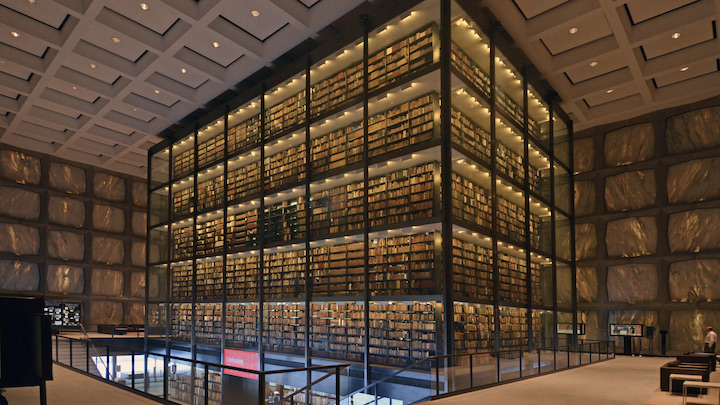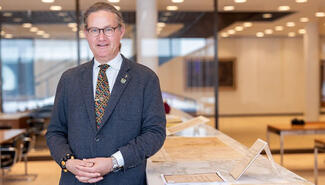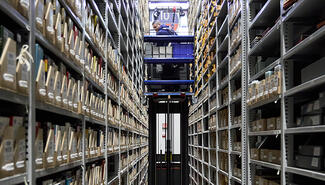Yale Library restructuring will unify special collections, increase access for researchers and visitors
Yale University Library is restructuring its special collections to support a unified collection strategy and service model. The changes give the Beinecke Rare Book and Manuscript Library, already Yale Library’s largest and best-known repository, an expanded leadership role for special collections across the university library system.
“Our goal is to provide faculty, students, and other researchers a more seamless and consistent research and teaching experience across our vast and diverse special collections,” said Barbara Rockenbach, Stephen F. Gates ’68 University Librarian. “The changes we are making will promote a more strategic approach to collection development and ensure that our collection materials are discoverable and usable as quickly as possible.”
Effective July 1, the staff, operations, and collections of Manuscripts and Archives, Yale Library’s second-largest repository, merged with those of the Beinecke. Under the leadership of Michelle Light, associate university librarian for special collections and director of Beinecke Library, the expanded, reimagined Beinecke is prioritizing user experience, sustainable stewardship, and increased collaboration within Yale Library, including with Preservation and Conservation Services and special collections in the Cushing/Whitney Medical Library, Divinity Library, Gilmore Music Library, Haas Family Arts Library, and Lewis Walpole Library.
“Researchers at Yale and around the world depend on our unique collections as the foundation for their original research,” Light said. “Our new vision, administrative structure, and allocation of resources will uplift all the special collections across Yale Library.”
Organizational changes
Located in Sterling Memorial Library, Manuscripts and Archives is home to the University Archives and some of Sterling’s most iconic spaces, including the Manuscripts and Archives Reading Room, the Gates Classroom, the Cowles Reference Center, and the adjacent Memorabilia Room. Its holdings include materials documenting 300 years of Yale history; Yale people around the world; and American political, legal, diplomatic, social, and cultural history from the 17th century to the present. In a typical pre-pandemic year, Manuscripts and Archives hosted approximately 3,500 researcher visits and responded to 6,500 reference inquiries.
Opened in 1963, the Beinecke is one of the world’s largest libraries devoted to rare books and manuscripts. Ranging from ancient fragments on papyrus to works by living authors, its collections also include photographs, maps, posters, paintings, and art objects, as well as audiovisual material and born-digital content. Beinecke Library hosts more than 10,000 research visits each year, and the building’s iconic architecture, public exhibitions, and community-focused programming attract thousands of non-research visitors as well.
The expanded Beinecke now has a staff of more than 140 people working in newly defined departments to acquire collections, prepare collections for discovery and use, support research and teaching, increase access to digital collections, and sustain community partnerships. A key goal is to develop a more unified approach to collection stewardship. To this end, staff members are analyzing workflows, experimenting with new approaches, and developing scalable infrastructure to increase capacity to catalog, organize, describe, preserve, and digitize materials in a timely way. “We want to make it easier for our users to find and use these materials, and also remain excellent and responsible stewards for the cultural heritage collections under our care,” Light said.
New teaching opportunities
For faculty teaching with primary sources and archival materials, the reorganization offers new opportunities. It is now possible to bring together materials from any library collection for a class session in any special collection classroom. “During the spring of 2022, processes were put into place so faculty teaching in the Gates Classroom could use materials from both Beinecke and Manuscripts and Archives collections in that space,” said Bill Landis, who transitioned on July 1 from associate director for public services at Manuscripts and Archives to the new position of education program director at the Beinecke. “The big change since July 1 is that we can now move Beinecke collection materials to any of our special collections reading rooms for instruction purposes.”
Faculty interested in teaching with a mix of collections may reach out to their existing contacts in any of the repositories or email beinecke.education@yale.edu. With at least two weeks’ lead time, “we’ll help them figure it out,” Landis said.
Information for visitors
The restructuring has not changed how individual researchers request and use collection materials. Manuscripts and Archives collections continue to be identified as such, and materials from these collections must still be requested for use in the Manuscript and Archives Reading Room in Sterling. Manuscripts and Archives continues to be the designated reading room for Music Library Special Collections as well. Beinecke collection materials may only be requested for use in the Beinecke Library Reading Room.
The integration of the Beinecke and Manuscripts and Archives collections is already enriching the Beinecke’s public programming. For a pop-up exhibit on Martin Luther King Jr. Day, more than 400 visitors to the Beinecke viewed materials from Manuscripts and Archives collections alongside materials from the James Weldon Johnson Memorial Collection of African American Arts and Letters. “We were able to uplift fuller, richer, more multi-faceted stories with the collections unified and staff working together,” said Michael Morand, Beinecke’s director of community engagement.
Next fall, Beinecke will take on administration of the Hanke Exhibition Gallery in the Sterling Memorial Library nave. The Hanke Gallery, opened in 2022, was constructed specifically to showcase exhibits that bring together materials from across the collections.
Acquisitions and stewardship
Individuals or organizations who previously donated records to Manuscripts and Archives may now work with a Beinecke curator on future donations and other matters. Inquiries may be emailed to beinecke.library@yale.edu. “As always, our ability to provide responsible stewardship for all material in our care will govern the conversations we have with donors and potential donors and decisions concerning what we are able to accept,” said Christine Weideman, formerly director of Manuscripts and Archives and now the Beinecke’s director of public services and operations.
The pace of acquisitions has slowed so that staff can focus on the reorganization and on making special collections backlogs more accessible to users. Beinecke is also collaborating with the other Yale Library special collections to define more unified collecting priorities and policies that will balance new acquisitions with the library’s capacity to care for them. New, more-sustainable collecting practices will focus on increasing the diversity of human experience represented in the collections and supporting evolving areas of scholarly inquiry.
“It is an exciting time to work in the Beinecke Library,” said Michelle Light. “Our staff have an incredible opportunity to innovate and lead our profession in the development of outreach and educational programs, as well as in best practices for sustainable stewardship of cultural heritage materials.”
—Patricia M. Carey



